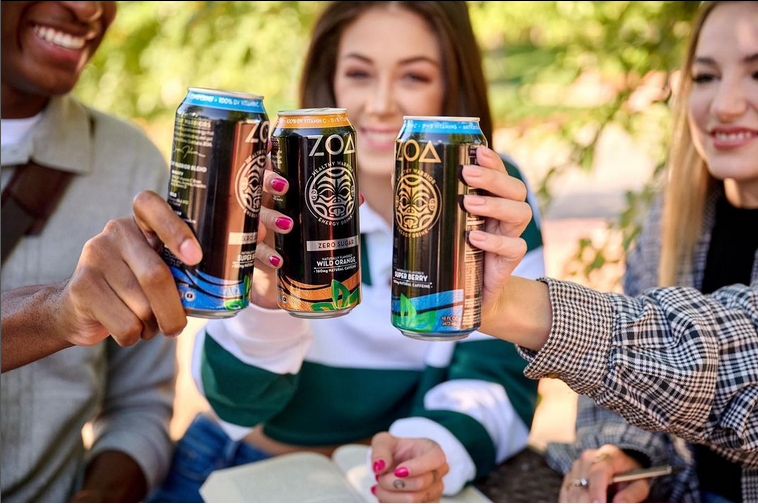It wasn’t long after ZOA burst onto the scene last year that it became the top-selling new energy drink of 2021 and a top-20 energy drink overall, according to IRI. Aimed at health-conscious consumers and made with all-natural ingredients, it arrived with the backing of Dwayne “The Rock” Johnson and quickly won over energy-drink consumers.
But it’s not just Johnson’s appeal helped make 2021 a blockbuster year for ZOA: it landed at a time when the energy drink market is proliferating, growing nearly 14% in 2021, according to IRI.
A Molson Coors analysis of industry data uncovered information about energy-drink consumers who shop at convenience stores. Among the key findings? They are reliable shoppers, they’re health conscious and they like to try new brands.
“The energy-drink consumer is not loyal to one brand or another. But that presents an opportunity to convert those shoppers to loyal customers. People want to try new things, so that puts a brand like ZOA is a good position,” says Darien Grant, who studies that convenience store market for Molson Coors Beverage Company. “Consumers are moving away from the established brands. They want something that is healthier, lower in calories, something new.”
About 25% of these shoppers say they’d buy another brand if their preferred brand wasn’t available, which has opened doors for brands like ZOA, which was developed by Johnson, strength and conditioning coach Dave Rienzi, businesswoman Dany Garcia and entrepreneur and investor John Shulman, and is marketed and distributed by Molson Coors.
With so many new options on shelves, consumers are finding more reasons to try different brands. In the last year 17 new franchises (and more than 260 new SKUs) hit the market. More than half of the category’s growth in convenience stores is due to new products, led, of course, by ZOA, Molson Coors found.
“ZOA has benefited from this trend, as consumers look for new brands they perceive as having benefits like less sugar and natural ingredients,” Grant says. “The challenge is holding on to them, which is why ZOA has embraced zero sugar options.”
Here are three more takeaways from Molson Coors’ analysis of convenience store trends:
They are reliable shoppers
Energy drinks are such a coveted commodity for shoppers that the most dedicated consumers – some 35% of them – hit up gas stations and convenience stores daily, Molson Coors found. Another 18% visit more than once a day.
“More than 70% of these trips are pre-planned. That shows us energy drinks drive purchases,” Grant says. “C-stores have a chance to keep that shopper in their store, to convert more shoppers while they’re in the store.”
Another surprising stat: around a quarter of all trips energy-drink consumers make are before 11 a.m.
“People are substituting energy drinks for coffee, it seems. It’s their pick-me-up before work,” Grant says.
They are health conscious
“We know this consumer identifies with being more health conscious,” Grant says, citing consumer insight studies. “They’re concerned about what they’re eating. Convenience store customers are often buying beer and snacks, but the landscape is changing, where people are gravitating towards healthier choices.”
In fact, Molson Coors research found that more than half of energy drink shoppers say they live “active lifestyles” and are “committed to their health and wellness.”
That means drinks like ZOA, which focuses on low- and no-sugar offerings with natural caffeine and vitamins, have an opportunity to win over customers that may have previously picked up Red Bull or Monster – both of which offer sugar-free options. There’s been such a proliferation in these beverages that it’s spawned an entirely new segment of so-called “healthy” energy drinks, including ZOA, Celsius, Alani and Cellucor’s C4. What’s more, two-thirds of U.S. dollar growth over the last 13 weeks is from zero-sugar energy drinks, according to IRI.
They also buy prepared meals
As c-stores continue to serve more health-minded customers – those who are looking for more than a bag of chips, a questionable hot dog and a slushie – they’re offering more prepared meals. Think sandwiches, salads and wraps. In fact, more consumers are stopping at c-stores for prepared meals, which make up more than 20% of sales and 34% of profits, excluding fuel, according to the National Association of Convenience Stores.
There’s a significant cross-section of consumers who also buy energy drinks, Molson Coors’ analysis found. More than six out of 10 energy drink shoppers purchase prepared meals when they shop at convenience stores. Increasing that number by 7% could mean a $35 million opportunity for c-stores, the analysis found.
“C-stores are becoming that destination for prepared meals. There’s a huge opportunity there if stores can cross-promote energy drinks and prepared meals,” Grant says.
ZOA is benefiting from consumers who are apt to try new products, a habit that’s helping the brand outperform competitors. With a repeat rate of 47%, ZOA outpaces the industry average of 42%. Meanwhile, it’s outselling established brands like Rockstar and Bang in dollars per trip.
“While energy-drink shoppers have shown they’re willing to experiment, ZOA came out of the gate really well. People are trying it and turning those trials into repeat purchases,” Grant says. “They’re looking for a product to speaks to them, and ZOA is proving to be just that.”

